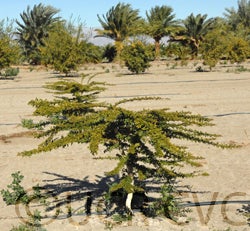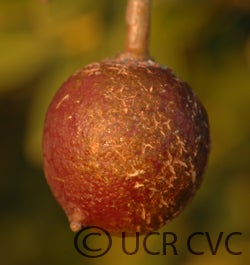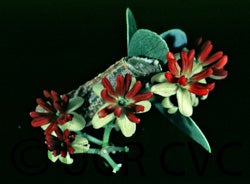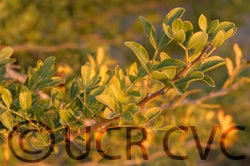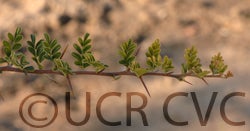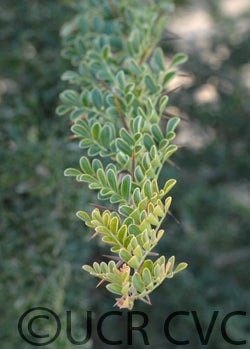Indian wood apple
CRC 3299
PI 236991
Source
Received as seed from E. Pollock, Parkes, N.S.W., Australia, 1957.
Parentage/origins
Parents unknown. Originally from Poona, India.
Rootstocks of accession
Own roots.
Season of ripeness at Riverside
Has not been observed.
Notes and observations
EMN, 1986: This accession may be too tender for the field at Riverside.
Description from The Citrus Industry Vol. 1 (1967)
"This species was described by Trimen (1893, p. 229) as follow: "A small tree, branches numerous, with smooth, whitish bark and with sharp, straight, ascending spines, 0.5-1.5 in. [1.2-3.8 cm] long; l. pinnate, 3-4 in. [7.5-10 cm long], rachis and petiole flat, very narrowly winged, glabrous, lfts. opposite, in 2 or 3 pairs and usually a terminal one, nearly sessile, 1-1.5 in. [2.5-3.8 cm long], oval or obovate, obtuse, entire, glabrous, basal ones the largest; fl. small, numerous, in small, paniculate, sessile cymes from the axils of fallen l., ped. slender, pubescent; cal. very small; pet. ovate, acute, spreading, smooth; stam. 7-12, fil. very short, anth. very large; disk finely woolly; ov. with numerous ovules in each cell, style very short, stigma fusiform; fruit large, 2-2.5 in. [5-6.3 cm diam.], globose, hard, pericarp woody, rough, whitish, 1-celled; seeds oblong, compressed." He stated further: "Flowers Feb. Mar.; pale green, stained with red purple, anthers dark red." Brandis (1906, p. 119) stated: "Flowers dull red, generally unisexual, in lax panicles, male and bisexual flowers frequently on the same inflorescence." He also noted that the leaves are deciduous.
In addition to the description given above, it should be noted that the calyx is deciduous, as Hooker (1875, vol. 1, p. 516) pointed out: "Calyx small, flat, 5-toothed, deciduous." He also noted that the leaves smell of aniseed and are deciduous. According to Guillaumin (1911, pp. 685, 687), the anthers are "twice as long as the filaments."
Although apparently universally reported as glabrous throughout except for the pedicels and peduncles, which are pubescent, and the base of the stamens, all the specimens that Swingle examined (from southeastern Asia, as well as greenhouse specimens from Washington, D.C.) show minute appressed yellowish-gray or nearly colorless hairs covering the petiole, rachis, and midribs of the very young leaves and also of the young twigs and spines. The very youngest new growth is covered almost as completely with these hairs as the very young growth of Glycosmis. These hairs soon disappear except at the joints of the rachis and base of the petiole. The seeds are pilose, as noted by Corrêa in his original description of the genus Feronia.
The wood-apple tree (sometimes called elephant apple), like the related bael-fruit tree (Aegle marmelos), also native in the hill regions of northern India, is deciduous; however, it is not reported as growing above 457 meters (1,500 feet) in the western Himalaya, whereas the bael tree in the same region grows up to 1,219 meters (4,000 feet). The wood apple is common in Ceylon in dry regions but the bael tree is not native so far south. The wood-apple tree is often planted in dooryard gardens in southern Asia and Java.
The ability to drop its leaves puts the wood apple in a special, small group of Citrus relatives. It will be well worth while to study the wood apple and the bael fruit as examples of subtropical Citrus relatives that have acquired the deciduous habit.
As Feronia limonia can be used successfully at least for a few years as a rootstock for Citrus, it should be compared with the trifoliate orange (Poncirus trifoliata), another deciduous Citrus relative that has been used with great success as a rootstock for kumquats and for the satsuma orange. Citrus when grafted on the wood apple is sometimes forced promptly into bloom. Such a graft might be utilized in an attempt to force newly originated or newly introduced varieties into bloom so that they may be used promptly in making other desired hybrids.
The ripe fruits of the wood apple contain a sour-sweet, aromatic pulp in which the seeds are imbedded. This pulp is sometimes eaten mixed with palm sugar or sweetened and stirred into coconut milk. It is also used to make a jelly said to be more or less astringent. A chutney is made from the pulp that is much liked by the natives. (See De Silva, 1890, p. 722; and Watt, 1890, vol. 3, pp. 326-27.) "
Availability
Not commercially available in California.
USDA Germplasm Resources Information Network page for Limonia acidissima
